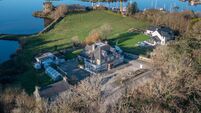Butterflies are changing along with the climate
The butterfly is an insect that brings to mind long, sunny summer days. Upwards of 28 different species can be found in Ireland.
But do we see as many of them as formerly or are some species thriving while others decline?
Even looking at this year alone, there are some very dramatic changes in relation to butterflies, according to Dr Liam Lysaght, director of the newly-established National Biodiversity Data Centre.
“Some species such as the Marsh Fritillary are in serious decline due to the loss of their wetland habitats. On the other hand, many of our commoner butterfly species are flying earlier this year, with butterflies such as the small tortoiseshell and red admiral flying in the depths of winter,” he points out.
A small tortoiseshell was seen flying on New Year’s Day in Macroom, Co Cork. There is evidence that species such as the Holly Blue and Speckled Wood are expanding their range in Ireland and Dr Lysaght believes this may be due to climate change, but can’t be certain.
At present, Ireland does not have a monitoring programme for butterflies but the Heritage Council aims to establish such a programme next year. This will give much-needed baseline data which is essential to monitor changes in our biodiversity.
“Ireland has agreed to halt the loss in biodiversity by 2010. This will be a very challenging target for the country and the first step is to establish baseline data on the range of wildlife and plants in the country and where each species is located,” Dr Lysaght says.
“This is one of the main objectives of the National Biodiversity Data Centre.”
Adult butterflies live for only a short time, during which they fly, mate and reproduce. The female lays an egg which is fertilised by the male and the egg hatches into a tiny caterpillar. The caterpillar, having grown, then attaches itself to a twig and forms a hard outer shell before changing into a butterfly. And so the cycle begins again.
Butterflies are sometimes confused with moths, but butterflies are day-flying while moths generally fly at night. A clearly distinguishing feature is the antennae. Butterflies always have threadlike antennae, but moths can have many types of antennae, some feathery.
The Heritage Council is launching a campaign to raise awareness of the decline in Ireland’s biodiversity and the loss of habitats such as boglands, natural grasslands, hedgerows and sand dunes.
It wants us all to do our part to help provide food and shelter for a huge number of birds, butterflies and other important wildlife. Growing native trees, shrubs and flowers or planting old-fashioned traditional garden plants from herbs to scented flowers provide more food and shelter than the newer hybrid and exotic breeds.
Everyone could play a part by planting native and traditional plants and using less moss peat, insecticide and other garden chemicals in their gardens and public spaces, says Dr Lysaght.
Changes in agricultural practices and the large-scale construction of roads, houses and shops are major contributors to Ireland’s declining biodiversity.
“While climate change and the arrival of invasive species such as the Zebra Mussel, Grey Squirrel and Hogweed are playing a significant role, the changes to our countryside from a decline in traditional farming practices to unprecedented development are having a profound effect on our biodiversity,” says Heritage Council chief executive Michael Starrett.
“European directives such as the Habitats Directive which brought us SACs (special areas of conservation) and the Birds Directive have played a very significant role in protecting our biodiversity over the past number of years. The shame is that such an approach had to be imposed on us by Europe.”
At this stage in our development, he adds, we should be in line with the rest of Europe in having systems, structures and legislation in place that allow us to manage local and regional biodiversity and effectively integrate it with other land uses.
“We have really not valued nature conservation or taken it seriously, and as a result are facing a whole range of environmental problems including loss of water quality,” he says.













